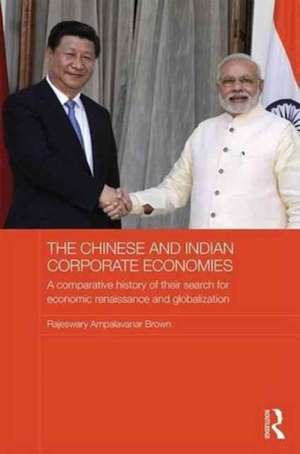The Chinese and Indian Corporate Economies: A Comparative History of their Search for Economic Renaissance and Globalization: Routledge Studies in the Growth Economies of Asia
Autor Raj Brownen Limba Engleză Hardback – 14 feb 2017
| Toate formatele și edițiile | Preț | Express |
|---|---|---|
| Paperback (1) | 426.83 lei 6-8 săpt. | |
| Taylor & Francis – 17 ian 2019 | 426.83 lei 6-8 săpt. | |
| Hardback (1) | 1341.06 lei 6-8 săpt. | |
| Taylor & Francis – 14 feb 2017 | 1341.06 lei 6-8 săpt. |
Din seria Routledge Studies in the Growth Economies of Asia
-
 Preț: 309.08 lei
Preț: 309.08 lei - 9%
 Preț: 934.91 lei
Preț: 934.91 lei -
 Preț: 326.49 lei
Preț: 326.49 lei - 8%
 Preț: 389.32 lei
Preț: 389.32 lei -
 Preț: 319.01 lei
Preț: 319.01 lei - 8%
 Preț: 389.25 lei
Preț: 389.25 lei -
 Preț: 422.04 lei
Preț: 422.04 lei - 28%
 Preț: 1045.20 lei
Preț: 1045.20 lei - 18%
 Preț: 1281.56 lei
Preț: 1281.56 lei - 18%
 Preț: 1052.38 lei
Preț: 1052.38 lei - 18%
 Preț: 784.00 lei
Preț: 784.00 lei - 18%
 Preț: 999.34 lei
Preț: 999.34 lei - 28%
 Preț: 823.63 lei
Preț: 823.63 lei - 18%
 Preț: 1120.07 lei
Preț: 1120.07 lei - 28%
 Preț: 877.59 lei
Preț: 877.59 lei - 18%
 Preț: 1118.46 lei
Preț: 1118.46 lei -
 Preț: 447.51 lei
Preț: 447.51 lei - 18%
 Preț: 1057.89 lei
Preț: 1057.89 lei - 30%
 Preț: 768.82 lei
Preț: 768.82 lei -
 Preț: 375.54 lei
Preț: 375.54 lei - 28%
 Preț: 746.22 lei
Preț: 746.22 lei - 18%
 Preț: 1053.92 lei
Preț: 1053.92 lei - 28%
 Preț: 820.80 lei
Preț: 820.80 lei - 18%
 Preț: 1059.84 lei
Preț: 1059.84 lei - 18%
 Preț: 1337.26 lei
Preț: 1337.26 lei - 28%
 Preț: 852.63 lei
Preț: 852.63 lei - 30%
 Preț: 851.82 lei
Preț: 851.82 lei - 18%
 Preț: 1002.63 lei
Preț: 1002.63 lei - 20%
 Preț: 248.97 lei
Preț: 248.97 lei - 28%
 Preț: 1045.83 lei
Preț: 1045.83 lei - 28%
 Preț: 988.47 lei
Preț: 988.47 lei - 28%
 Preț: 821.29 lei
Preț: 821.29 lei - 18%
 Preț: 1218.08 lei
Preț: 1218.08 lei - 18%
 Preț: 1113.16 lei
Preț: 1113.16 lei - 18%
 Preț: 1048.43 lei
Preț: 1048.43 lei - 28%
 Preț: 849.29 lei
Preț: 849.29 lei - 28%
 Preț: 821.46 lei
Preț: 821.46 lei - 18%
 Preț: 1004.72 lei
Preț: 1004.72 lei - 28%
 Preț: 823.63 lei
Preț: 823.63 lei - 18%
 Preț: 1334.90 lei
Preț: 1334.90 lei - 28%
 Preț: 823.08 lei
Preț: 823.08 lei - 18%
 Preț: 1056.00 lei
Preț: 1056.00 lei - 19%
 Preț: 280.13 lei
Preț: 280.13 lei - 18%
 Preț: 1054.27 lei
Preț: 1054.27 lei - 31%
 Preț: 765.77 lei
Preț: 765.77 lei - 20%
 Preț: 251.08 lei
Preț: 251.08 lei - 28%
 Preț: 990.57 lei
Preț: 990.57 lei -
 Preț: 378.22 lei
Preț: 378.22 lei - 28%
 Preț: 819.67 lei
Preț: 819.67 lei
Preț: 1341.06 lei
Preț vechi: 1635.44 lei
-18% Nou
Puncte Express: 2012
Preț estimativ în valută:
256.64€ • 278.68$ • 215.58£
256.64€ • 278.68$ • 215.58£
Carte tipărită la comandă
Livrare economică 23 aprilie-07 mai
Preluare comenzi: 021 569.72.76
Specificații
ISBN-13: 9781138929883
ISBN-10: 1138929883
Pagini: 490
Ilustrații: 6
Dimensiuni: 156 x 234 mm
Greutate: 0.86 kg
Ediția:1
Editura: Taylor & Francis
Colecția Routledge
Seria Routledge Studies in the Growth Economies of Asia
Locul publicării:Oxford, United Kingdom
ISBN-10: 1138929883
Pagini: 490
Ilustrații: 6
Dimensiuni: 156 x 234 mm
Greutate: 0.86 kg
Ediția:1
Editura: Taylor & Francis
Colecția Routledge
Seria Routledge Studies in the Growth Economies of Asia
Locul publicării:Oxford, United Kingdom
Public țintă
Postgraduate and UndergraduateCuprins
1. Two Major Asian Peripheries, China and India, and their Distinct Corporate Economies: The Silent Tongue of " One Asia Or Many".
2. The Restructuring of China’s State Owned Enterprises since 1978
3. Chinese Retailers Abroad and China’s Consumption Patterns at Home: The Prosperity of Prada and a Sorcery of Branded Luxury.
4. The Silent Vulgar Tongue: Guanxi and Trust in Chinese Corporations.
5. Financial Reform in China, Banking State and Efficiency
6. The Development of the Chinese Stock Market and Globalization of Chinese Corporations and Financial Markets
7. The Role of Labour in Agrarian and Industrial Dynamics of Change
8. Utilitarian Blindness to Innovation Mistaken for Sight in China’s Search for Acquisition of Western Magic Pagodas.
9. China and Globalization Strategy and Scope.
10. Corporate Institutions and Law in India: State, Space and the Capitalists.
11. Tata and Sons: Appropriating and Keeping the State in Space.
12. Indian Financial Institutions: Law Renaissance, Illusions and Realities.
13. Rethinking the Corporate and Financial Institutions of Islam through the Moral Economy of the Waqf
14. From Empire to Independence to Economic Liberalism and Globalization: Indian Labour’s Journey
15. Chinese and Indian Corporate Economy: A Radical Construction of Law, the State and Corporations
16. Conclusion
2. The Restructuring of China’s State Owned Enterprises since 1978
3. Chinese Retailers Abroad and China’s Consumption Patterns at Home: The Prosperity of Prada and a Sorcery of Branded Luxury.
4. The Silent Vulgar Tongue: Guanxi and Trust in Chinese Corporations.
5. Financial Reform in China, Banking State and Efficiency
6. The Development of the Chinese Stock Market and Globalization of Chinese Corporations and Financial Markets
7. The Role of Labour in Agrarian and Industrial Dynamics of Change
8. Utilitarian Blindness to Innovation Mistaken for Sight in China’s Search for Acquisition of Western Magic Pagodas.
9. China and Globalization Strategy and Scope.
10. Corporate Institutions and Law in India: State, Space and the Capitalists.
11. Tata and Sons: Appropriating and Keeping the State in Space.
12. Indian Financial Institutions: Law Renaissance, Illusions and Realities.
13. Rethinking the Corporate and Financial Institutions of Islam through the Moral Economy of the Waqf
14. From Empire to Independence to Economic Liberalism and Globalization: Indian Labour’s Journey
15. Chinese and Indian Corporate Economy: A Radical Construction of Law, the State and Corporations
16. Conclusion
Notă biografică
Rajeswary Ampalavanar Brown is Emeritus Professor in International Business at Royal Holloway College, University of London. She is the author of The Indian Minority and Political Change in Malaya, 1945-1957; Capital and Entrepreneurship in South East Asia; Chinese Big Business and the Wealth of Asian Nations; The Rise of the Corporate Economy in South East Asia; and Islam in Modern Thailand: Faith, Philanthropy and Politics.
Recenzii
"A richly detailed and accessible comparison of development in China and India. Rajeswary Ampalavanar Brown combines insights of the economist and the business historian, weaving together first-hand knowledge of an impressive field of topics, from farms to financial markets, and from moral economy to corporate branding. Her sophisticated analysis leaves behind clichéd images of Asian business, revealing the complex interplay of global norms and culturally specific practices like waqf trusts and guanxi relations, as well as the interaction between common law and national capitalism, and corporate strategies to emulate and supplant foreign competitors."
Thomas DuBois, Australian National University (ANU), Australia.
"This insightful and ambitious book seeks to explain the contrasting pathways of capitalist transformation in two of the largest economies of the world, India and China, paying attention to the role of the state, legal infrastructure, cultural practices, and resource endowments. An essential reading for economists and historians interested in the 'emergence' of Asia, the book confirms Professor Brown’s reputation as a foremost authority on Asian capitalism."
Tirthankar Roy, Professor of Economic History, London School of Economics and Political Science, UK.
Thomas DuBois, Australian National University (ANU), Australia.
"This insightful and ambitious book seeks to explain the contrasting pathways of capitalist transformation in two of the largest economies of the world, India and China, paying attention to the role of the state, legal infrastructure, cultural practices, and resource endowments. An essential reading for economists and historians interested in the 'emergence' of Asia, the book confirms Professor Brown’s reputation as a foremost authority on Asian capitalism."
Tirthankar Roy, Professor of Economic History, London School of Economics and Political Science, UK.
Descriere
This book examines the economic growth of China and India, and takes a long historical view, combining economic history with an analysis of the current situation. It considers the nature of capitalism in the two countries, their institutional structures, legal frameworks, state industrial strategies, and their different approaches to state-owned enterprises and the encouragement of entrepreneurs and investors. It thereby provides a comprehensive overview of the strategic factors driving growth in both countries. It shows that growth is not driven by an imitation of Western models, and concludes by assessing the prospects for continued growth in future in both China and India.















